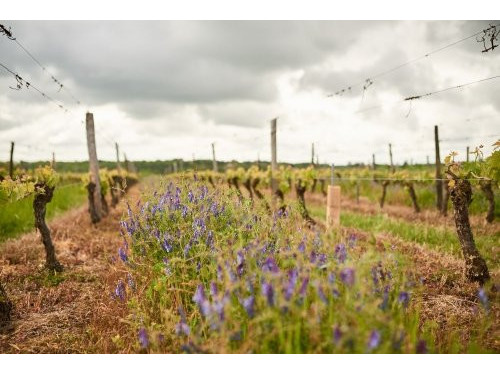How we use cover crops in our vineyards
23/05/2022
Traditionnally, the weeds are removed from the alleys between the rows of vines. Here, at the cooperative Les Vignerons de Buzet, we cover a large part of our soils by sowing different species according to the vineyards’ needs, the rolling them (without cutting them !), thereby creating a natural protective carpet.
By choosing the cover crop technique, we were looking for a natural way of retaining water in the soil and limiting its evaporation. What’s more, the practice has positive benefits on the structure of the soils and on the environment in general.
Cover crops are helpful to :
- Increase biodiversity (nectar-producing species)
- Limit erosion and losses through leaching
- Improve soil structure
- Enhance biological activity in the soil
- Have a better water retention
Today, two thirds of our vineyard is cultivated with the use of cover crops. As Carine Magot, head of the vineyard service at our cooperative Les Vignerons de Buzet, explains in this video (in french), cover crops are one of the techniques used by our winegrowers to cultivate their vines on living soil.
SCEA Gueyze et domaines : Réduire l'IFT from Solagro on Vimeo.
Carine MAGOT Nous explique comment la diversité culturales et l'implantation d'un couvert inter-rang lui permets de réduire considérablement les traitements qu'elle pourrait apporter à sa vigne.
Retrouver le témoignage complet ici https://osez-agroecologie.org/eric-pozzoli
Some species of cover crops that you recognize on our vineyard
All cover crops species contribute to biodiversity, act as carbon traps and have a positive effect on water purity.
However, each is more or less effective for certain actions. The different species can be mixed, providing a great wealth of natural interactions between the and the vine. Here are a few examples of cover crops planted between our rows of vines:
- Brassicas (for example : Yellow mustard)
Decompaction of surface soil thanks to their root system. In addition to improving soil structure, the roots of brassicas soak up water like sponges, acting as water réservoirs.
- Leguminous plant (for example : Broad bean)
Plants of the legume family « fix » nitrogen from the air and naturally release it back to the vine. They therefore replace, in part at least, the use of fertilizers (organic on our wineyard). Nitrogen is one of the major constituents of plants, playing an essential rôle in both their physiology and development.
- Grasses (for example : Rye)
Deep soil decompaction thanks to their particularly strong root system. Grasses are also very effective in recycling minerals (including nitrates).
